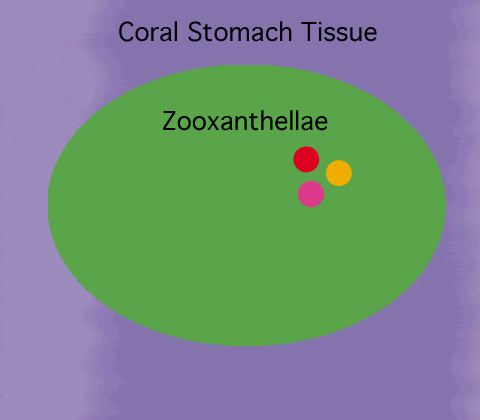What Lives Inside The Tissues Of The Polyp Animal
Zooxanthellae ... what's that?
Corals Tutorial
Most reef-building corals comprise photosynthetic algae, chosen zooxanthellae, that live in their tissues. The corals and algae take a mutualistic relationship. The coral provides the algae with a protected environment and compounds they demand for photosynthesis. In return, the algae produce oxygen and aid the coral to remove wastes. Most importantly, zooxanthellae supply the coral with glucose, glycerol, and amino acids, which are the products of photosynthesis. The coral uses these products to make proteins, fats, and carbohydrates, and produce calcium carbonate. The human relationship between the algae and coral polyp facilitates a tight recycling of nutrients in food-poor tropical waters. In fact, as much as ninety per centum of the organic material photosynthetically produced by the zooxanthellae is transferred to the host coral tissue. This is the driving force backside the growth and productivity of coral reefs.
In addition to providing corals with essential nutrients, zooxanthellae are responsible for the unique and cute colors of many stony corals. Sometimes when corals become physically stressed, the polyps expel their algal cells and the colony takes on a stark white appearance. This is commonly described as "coral bleaching". If the polyps go for too long without zooxanthellae, coral bleaching can event in the coral'due south death.
Because of their intimate relationship with zooxanthellae, reef-building corals respond to the environment like plants. Reef corals require clear water and then that sunlight can reach their algal cells for photosynthesis. For this reason they are generally found only in waters with small amounts of suspended material, or water of depression turbidity and low productivity. This leads to an interesting paradox—coral reefs require clear, nutrient-poor water, but they are amidst the most productive and various marine environments.

Zooxanthellae cells provide corals with pigmentation. On the left is a healthy stony coral. On the right is a stony coral that has lost its zooxanthellae cells and has taken on a bleached appearance. If a coral polyp is without zooxanthellae cells for a long period of time, it will near probable die.

Coral polyps, which are animals, and zooxanthellae, the constitute cells that live within them, have a mutualistic human relationship. Coral polyps produce carbon dioxide and water as byproducts of cellular respiration. The zooxanthellae cells use carbon dioxide and water to acquit out photosynthesis. Acquire more.

Tiny constitute cells called zooxanthellae live within virtually types of coral polyps. They aid the coral survive by providing it with food resulting from photosynthesis. In turn, the coral polyps provide the cells with a protected environment and the nutrients they need to carry out photosynthesis.
Source: https://oceanservice.noaa.gov/education/tutorial_corals/coral02_zooxanthellae.html#:~:text=Tiny%20plant%20cells%20called%20zooxanthellae,need%20to%20carry%20out%20photosynthesis.
Posted by: williamshicess.blogspot.com

0 Response to "What Lives Inside The Tissues Of The Polyp Animal"
Post a Comment